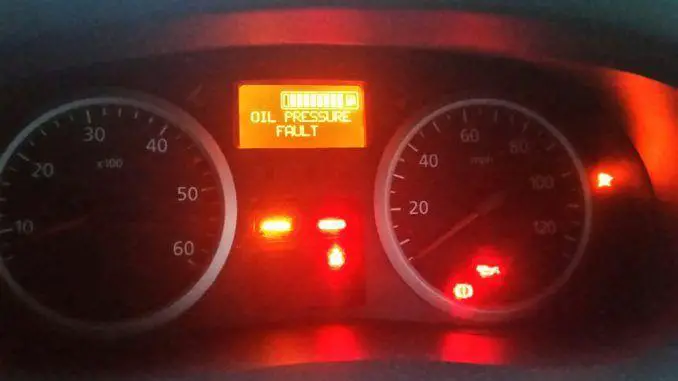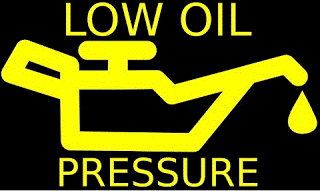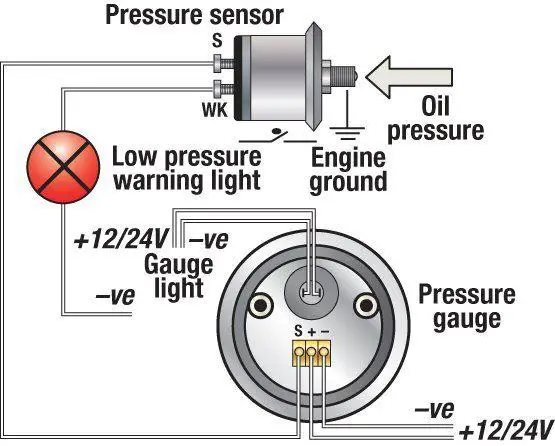Once in your lifetime, you’ll experience the low-pressure light on your dashboard while driving. If the low oil pressure warning light comes, it indicates that the engine has low engine oil pressure. If you don’t get it checked immediately, the low-pressure light can lead to irreversible damage to your car’s engine. Switch off the vehicle directly to avoid any further damage.
Even if the correct amount of oil was added, it might be excessively consumed due to evaporation, burnout of pistons, or leaks. Excess oil consumption increases your engine’s age. So, it’s better to get it checked regularly.
Let’s find out what are the common reasons which might result in low oil pressure light.

Common causes leading to low oil pressure light:
The common factors which might result in low oil pressure light include:
- Low engine oil level- When there is a low engine oil level, it can cause increased friction, enhanced ageing of the engine, and worsening its performance.
- Low engine oil pressure- the low oil pressure can occur due to the age of the engine. Once the oil pressure is insufficient, it’s ideal for checking it immediately, as, in the long run, it can have a disastrous effect on your car’s engine.
- Engine oil is either too thick or thin- when the oil viscosity is either high or low, it might result in loss of oil pressure. Low oil viscosity results in low resistance leading to low oil pressure. High viscosity oil leads to greater resistance resulting in less lubrication and ultimately low pressure.
- Faulty oil pressure sensor- if the oil level seems perfect and you got it checked, but still the oil pressure light is on, it might indicate a defective oil pressure gauge.
- Worn out oil pump- if the oil pressure level is full but with the noisy engine, it indicates a worn-out oil pump. That won’t generate enough pressure, so you need immediate replacement of the oil pump.
- Worn out engine bearings- if the oil pressure is low, it might occur due to worn out engine bearings because of high mileage.
- Blockage of the oil filters- within the lubrication system, the oil filter is first installed, and then a pressure gauge is placed. If the filter gets clogged because of the contaminants with incorrect operation of the bypass valve, it might result in lubricant starvation. Clogged oil filters usually occur due to overextended oil caused by soot or water contamination.
Have a look at the video and understand what causes the low oil pressure light to blink on.

Can you drive a car with low oil pressure?
The simple answer to this question is NO. Continuing to drive with a low oil pressure indicator can severely damage the engine, leading to hefty expenditure. It’s, therefore, essential to immediately identify the cause of low pressure.
How do you fix low oil pressure warning light?
Before you plan on fixing this issue, check the level of the oil by using a dipstick, whether the problem is severe or mild.

Try adding oil to your car engine:
Return the oil level to the complete mark and check the oil level with the dipstick. Add oil to the engine if it indicates low oil. Avoid overfilling the crankcase. You can also check the user manual and utilize the appropriate type of oil with perfect viscosity.
Try replacing the oil pressure sending unit:
If the oil pressure warning light is still on, connect the oil pressure gauge with the engine, and remove the oil pressure sending unit. Check whether it is generating enough pressure when the engine is started. If the output is enough, it’s not an oil pump problem. It tells the oil pressure sending unit is faulty.
Replace the old pressure sending unit with the new one. Now, test again with the oil pressure switch using a pressure gauge. If the output is expected, the oil pressure light will be off. If the pressure oil gauge is still showing a low reading, suspect a faulty oil pump.
Try replacing the oil pump:
If the oil pump is not generating sufficient pressure, try changing the oil pump. The oil pump is present within the oil pan underneath the engine. Remove the oil pan and replace the oil pump. For removing the oil pan, you need to remove the steering wheel or remove suspension components. You might be required to raise the engine. In some machines, you may find the oil pan in the timing cover, front of the engine, so you need to remove the components. For such kinds, you would want extra time and more power to replace the oil pump.

Replace engine bearings:
The oil engine pressure might not be enough, and you can check through a pressure gauge, and it also results in a noisy engine. If the pressure results are around 10psi for each 1000 RPM, it indicates the perfect oil pump condition. If the results are not proper, the engine bearings are faulty and worn out. So, it would help if you replace those.
Oil leaks:
This might occur at covering gaskets/ oil pan, the front and rear seals of crankshaft oil, and valve cover. To check out the oil leakage issue, look at the sides, bottom, and top of the engine. Diagnose whether there is a heavy accumulation of greasy stains and oil dripping over the ground. Replace the seals and gaskets if they are leaky.
Worn out valve guide seal:
Suppose you find out low oil level but no oil leaks and the engine is all clean, there are high chances that piston rings are either worn out, or the valve guide seals malfunction. This might occur due to high mileage wear and tear. Keep a check with the dipstick regularly and keep enough oil on hand.
Watch how you can fix the low oil pressure issue with a simple tutorial video along with the step-by-step guide:
How much does it cost to fix low oil pressure?

If there is a problem in head gaskets, it leads to low oil pressure; replace them. The head gaskets usually last for around 100,000 miles. The cost to fix the head gaskets is about $1170- $1496. The labour cost for the replacement of head gaskets is between $900-$1148. However, for additional parts, it might cost $260- $348.
If the head gaskets are not troubling, check other parts of your car’s engine. If other factors are causing low oil pressure, the average replacement cost is around $3000-$4000. For new engines like V6, the price can rise to $5,500 and for V8 to about $7,000.
However, to ensure the oil pressure light is gone, you need to get your car checked. Immediately.
What are the symptoms of low oil pressure?
Several factors can lead to low oil pressure warning light, including oil leaks.
Low oil pressure warning light:
It is one of the earliest signs which indicates an oil pressure problem. Modern vehicles these days have warning system connectivity to the sensors within the engine oil arrangement. If the oil pressure falls to a particular point, it can trigger the sensor, and the pressure warning light comes.
Clunking engine noise:
Oil performs the most crucial function of lubrication. If the oil level is low, the lubrication is not enough leading to grinding, loud clunking, or knocking sounds. This sign indicates that the engine is falling apart. So, you need to resolve it immediately.
Burning oil smell:
The burning smell usually indicates some external oil leakage. The cracks in pipes or hoses can result in oil dripping over the hot metallic surfaces leading to a burning smell. This smell usually occurs when you drive, and the engine keeps running. When you notice such mishaps, it’s high time to stop the car nearby and check the oil level to identify the problem immediately.
Faulty engine performance:
Oil is an essential ingredient that offers enough lubrication to reduce friction between your car’s engine’s moving components. Once the conflict is over, it makes your engine power and shows maximum efficacy. On the other hand, if the oil level or the oil pressure is low, it can enhance friction, leading to the excess workload on the engine. This indicates that the machine will work hard to perform. The low performance of the motor will also affect fuel consumption power.
Overheating of the engine:
Once the oil pressure is low and is not sufficient, it will result in overheating of the machine. We know it’s usually the cooling system’s function, but the motor oil also plays a vital role in reducing friction and preventing overheating. So, it’s better to review your engine oil level if you experience an overheating engine.
Conclusion:
Motor oil pressure is essential to maintain a functioning engine. Motor oil is the vital fluid that efficiently lubricates all the metallic components and minimizes any friction or overheating of the motor components. Sufficient oil pressure enhances the lifespan of the engine and protects it against wear and tear.
Low oil pressure can affect the engine’s performance along with its durability in the long run. So, what are you waiting for? If the oil pressure light comes, check it, and resolve the issue immediately while following our simple guide.
